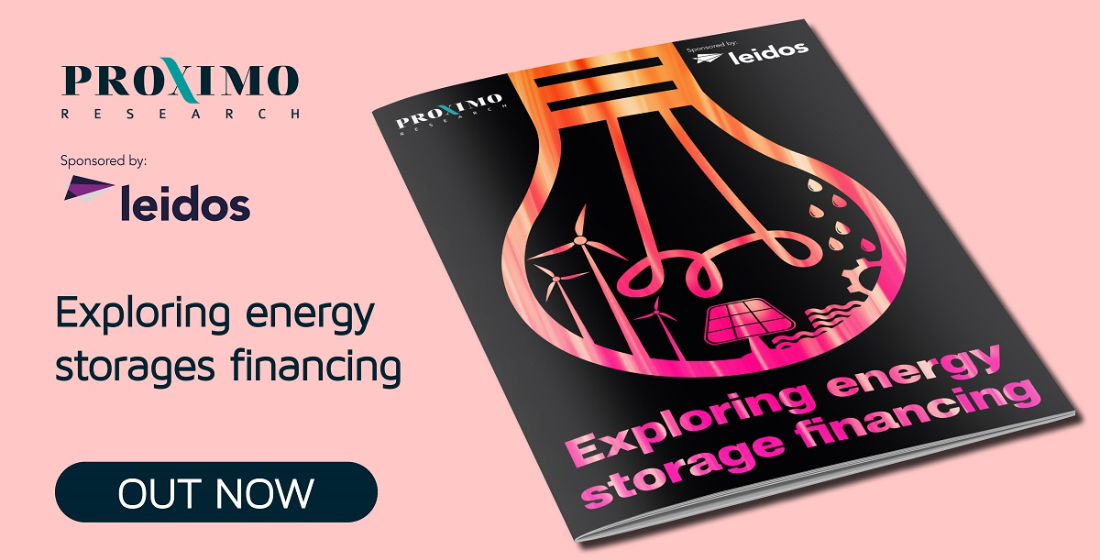Exploring energy storage financing
Research Report: Exploring energy storage financing. Sponsored by Leidos, this report presents the latest market trends in energy storage project finance. Find out more and download your copy here.

The aim of this report has been to present the latest market trends in energy storage project finance. To meet this aim, a mixed methodology that combined 108 survey respondents with interview data collected from six consenting individuals. This report concludes:
Energy storage project finance is in a healthy position moving forward.
There is no doubt that energy storage project finance is starting to gain real momentum, particularly in North America and in Europe, where the UK is setting the pace. Commercialisation of energy storage is the next step and it now feels like a case of when and not ‘if’. New technologies which facilitate storage and other distributed generation options are increasing in value, and with the need to balance supply and demand, particularly as renewable energy becomes more common, energy storage projects will likely hold their value too. Project finance has a key role to play in taking this industry forward, but regulatory and policy changes need to catch up to ensure that benefits of project finance can be maximised.
Revenue stacking of ancillary services will encourage more developers to enter the market, a move which should facilitate technological innovation and reduce the cost of energy to the customer.
The multitude of services from energy storage projects is a unique feature of the industry. Short-term operating reserve, demand management, fast reserve, and frequency response are just some of the applications that can be utilised by developers to stack revenue streams, which, in turn, increase project cashflows and attractiveness to bank and non-bank financing. However, regulatory change is needed to allow network operators to generate revenue from multiple services, thereby making it a viable to alternative to network reinforcement. Policy changes are also needed to promote more investment in research and development to aid competitiveness of the energy storage markets.
No universal power purchase agreement – no problem.
As government subsidies have been withdrawn from renewable and energy storage projects, PPAs were seen as a vital tool for developers to lock in long-term pricing and stable yields. However, as the qualitative data showed in this report, the industry is starting to see a shift away from PPAs towards merchant risk. As this shift occurs, the main benefit of PPAs, namely, to provide a lender with confidence that a buyer commits to paying a fixed price for a long tenor, becomes harder for equity investors to justify, as it provides a material discount to any current or future pricing increases.
Non-recourse project financing looks set to play a role in the proliferation of energy storage projects.
While there has been a slow evolution of non-recourse project financing in energy storage, the tide appears to be turning. Historically, there have only been a handful of non-recourse battery storage project financings, mostly because of they require contract terms that are unattractive to customers and the lack of clarity that existed around their revenue streams. However, ever since the landmark deal that saw Oregon-based Powin Energy secure non-recourse construction financing for an 8.8MW/40.8MWh battery storage facility in Stratford, Ontario, non-recourse financing has become increasingly suited to capital-intensive energy storage projects that deliver regular income over long periods of time. This brings energy storage more in line with its wind and solar project finance counterparts.
A challenging industry but one with a significant upside.
No sector in project finance is without its challenges but for the relatively nascent energy storage sector, there are several challenges that could stop it becoming a truly global sector. Changing demands, decarbonisation, security of supply, the need to improve energy networks, and ageing infrastructure all pose questions for developers, asset owners, and investors. But for developers and investors, the opportunity to deliver stack ancillary revenue sources in a post-subsidy world will lead to strong returns on investment, certainly above those from oil and gas. For the end consumer, increased efficiency from improved grid management and the integration of renewable power will lead to a reduction in costs and a more reliable system. For this to happen, regulatory and policy changes are needed to ensure the industry is able to maximise its full potential.
For more information on the report, please get in touch with us at team@proximoinfra.com.
Request your copy of the energy storage financing research report today. Visit our Research page and complete the appropriate form to receive a copy directly to your inbox.





